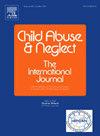《儿童及早期青少年受害问卷自述》的适应与心理计量学评价
IF 3.4
2区 心理学
Q1 FAMILY STUDIES
引用次数: 0
摘要
有证据表明,向儿童询问他们的生活是可能的,而且具有独特的价值,关于儿童的参与权也有国际协议。然而,关于儿童受害的研究传统上依赖于代理举报人或回顾性问卷调查。询问儿童经历的工具以访谈的形式进行管理,不报告心理测量特性,目标儿童超过11岁(0岁)。本研究采用了世界上最强大、最全面、最广泛使用的测量暴力侵害儿童行为的工具——青少年受害问卷(JVQ) (Finkelhor, Ormrod等人,2005年),为8至12岁的儿童编写了一个自我报告版本。我们分三个阶段收集了效度和信度的证据:专家评估(n = 38),儿童认知访谈和焦点小组(n = 25),儿童试点测试(n = 782)。结果研究结果和参与者的建议形成了一个15项的版本,评估了5个模块(电子伤害、性伤害、同伴和兄弟姐妹伤害、照顾者伤害和暴力暴露)。该版本在效度(例如,预期方向和幅度的相关性)和可靠性(例如,项目之间的连通性)方面显示了足够的心理测量特性。儿童的参与是确保全面和无重大困难的关键。根据关于儿童参与权的国际协议,这个版本的儿童和早期青少年联合调查(JVQ- cea)允许将8至12岁儿童的声音纳入儿童受害研究。本文章由计算机程序翻译,如有差异,请以英文原文为准。
Adaptation and psychometrical assessment of the Juvenile Victimization Questionnaire self-report for Children and Early Adolescents (JVQ-CEA)
Background
Evidence shows that asking children about their lives is possible and uniquely valuable, and there are international agreements on children's right to participation. However, research on child victimization has traditionally relied on proxy informants or retrospective questionnaires. Instruments for asking children about their experiences are administered as interviews, do not report psychometric properties and target children over 11 years old (y.o.).
Objective
This study presents an adaptation of the world's most robust, comprehensive, and widely used instrument for measuring violence against children, the Juvenile Victimization Questionnaire (JVQ) (Finkelhor, Ormrod, et al., 2005), in a self-report version for children between 8 and 12 y.o.
Methods
A first version was proposed based on methodological recommendations. We gathered evidence of validity and reliability in three phases: an expert review (n = 38), cognitive interviews and focus groups with children (n = 25), and a pilot test with children (n = 782).
Results
The results and participants' suggestions led to a 15-item version assessing five modules (electronic victimization, sexual victimization, peer and sibling victimization, caregiver victimization, and exposure to violence). This version demonstrated adequate psychometric properties in terms of validity (e.g., correlations in the expected direction and magnitude) and reliability (e.g., connectedness among items). Children's participation was key to ensure comprehensiveness and no major distress.
Conclusions
This version of the JVQ for Children and Early Adolescents (JVQ-CEA) allows the voices of children between 8 and 12 y.o. to be included in child victimization research, in accordance with international agreements on children's right to participation.
求助全文
通过发布文献求助,成功后即可免费获取论文全文。
去求助
来源期刊

Child Abuse & Neglect
Multiple-
CiteScore
7.40
自引率
10.40%
发文量
397
期刊介绍:
Official Publication of the International Society for Prevention of Child Abuse and Neglect. Child Abuse & Neglect The International Journal, provides an international, multidisciplinary forum on all aspects of child abuse and neglect, with special emphasis on prevention and treatment; the scope extends further to all those aspects of life which either favor or hinder child development. While contributions will primarily be from the fields of psychology, psychiatry, social work, medicine, nursing, law enforcement, legislature, education, and anthropology, the Journal encourages the concerned lay individual and child-oriented advocate organizations to contribute.
 求助内容:
求助内容: 应助结果提醒方式:
应助结果提醒方式:


